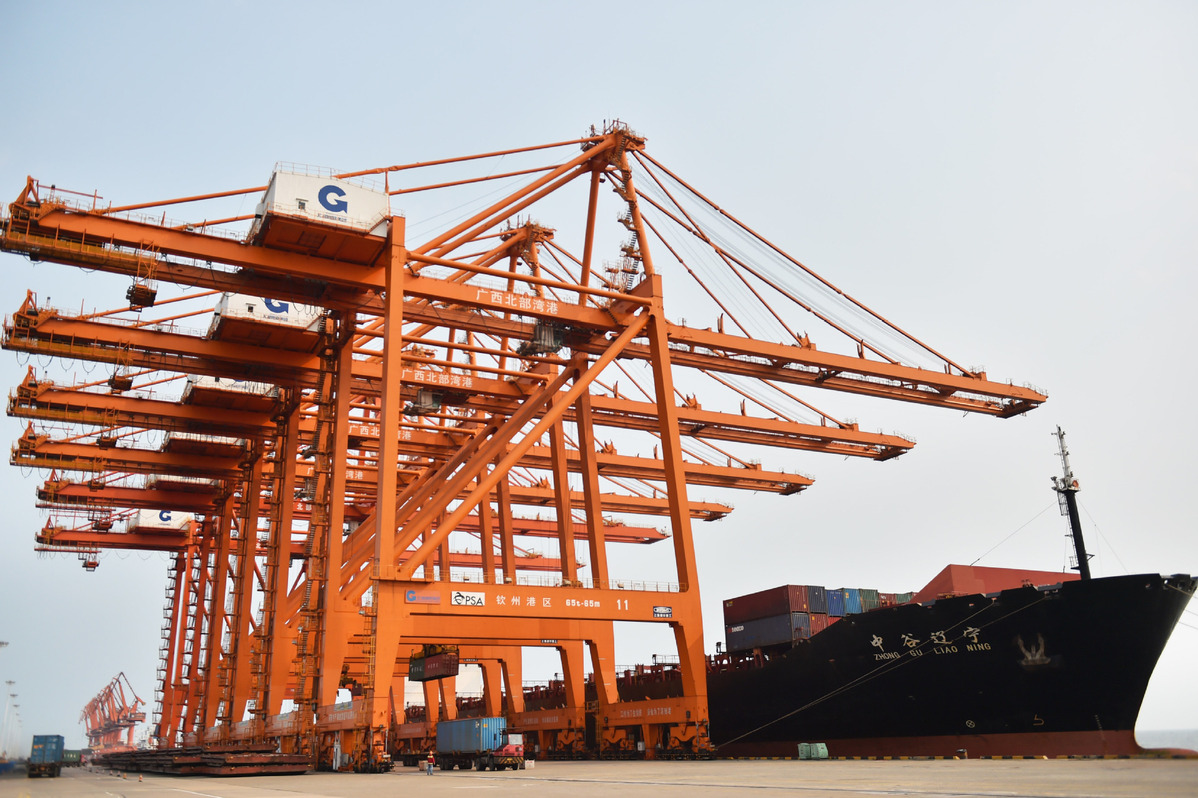China-ASEAN commerce, investment to help boost global recovery amid downside pre
 A cargo ship docks at Qinzhou Port in China-ASEAN Free Trade Area in Qinzhou, Guangxi Zhuang autonomous region, on July 11, 2020. [Photo/Xinhua]
A cargo ship docks at Qinzhou Port in China-ASEAN Free Trade Area in Qinzhou, Guangxi Zhuang autonomous region, on July 11, 2020. [Photo/Xinhua]
The ever-strengthening economic and trade cooperation between China and the Association of Southeast Asian Nations will further unleash growth potential on both sides to improve the welfare of people in the region while also helping with global economic recovery, according to experts and business executives.
ASEAN member states have long been priority destinations for China's foreign trade and outbound investment activity, and closer bilateral ties will significantly promote free flows of production factors and investment in the region, and therefore strongly boost the integration of industrial and supply chains to bolster regional development and the global economy, they said.
Their comments came as Chinese President Xi Jinping and leaders from ASEAN jointly mapped out a new vision for future cooperation on Monday, elevating bilateral relations to a comprehensive strategic partnership.
"The ASEAN countries have different levels of development and resource endowments, and thus have strong economic and trade complementarity with China," said Tu Xinquan, dean of the China Institute for WTO Studies at the University of International Business and Economics in Beijing.
Thanks to mutually recognized economic and trade rules and arrangements over the years, bilateral trade between the two sides surged from less than $8 billion in 1991 when they established dialogue relations, to $684.6 billion last year, said the Ministry of Commerce.
About 90 percent of goods traded between the two sides enjoy zero-tariff treatment, and China has been ASEAN's largest trading partner for 12 years in a row, while ASEAN became China's largest trading partner last year.
During the first 10 months, China-ASEAN trade totaled $703.3 billion, up 30 percent year-on-year, indicating a probable record for the full year.
Zhang Jianping, director-general of the China Center for Regional Economic Cooperation, said China and ASEAN have even greater cooperation potential in areas such as infrastructure, energy and resources, agriculture, manufacturing and modern services.
"China and ASEAN will become the largest and most energetic emerging markets in the Asia-Pacific region, and the integration of the regional economy will be accelerated, driven by the strengthening bilateral economic and trade cooperation," Zhang said.
Wang Zhengbo, president of Guangxi TWT Supply Chain Management Co Ltd, said he felt "extremely confident" in enterprise growth thanks to the bright China-ASEAN trade prospects. The company, based in Nanning, the Guangxi Zhuang autonomous region, is an agricultural trader focused on ASEAN products.
"Thanks to the deepening economic and trade cooperation between China and ASEAN, it is getting increasingly convenient for the Chinese people to enjoy Southeast Asian fruits, such as durian, mangosteen and longan," he said.
"At the same time, the huge and expanding market in China also motivates ASEAN people to produce more fruit, boosting profitability and development of the agriculture sector in ASEAN."
The company has offices in all the major ports of the autonomous region, and total volume of both cross-border trade and logistics of the company registered double-digit growth in recent years.
The integration of the regional industrial, supply and value chains of China and ASEAN has also been constantly deepening, according to experts.
In 2020, bilateral processing trade, which involves importing components and exporting finished products, totaled $141 billion, making up 20.6 percent of total trade, while trade in raw materials and intermediates also accounted for an important share of the bilateral trade, official commerce data showed.
The Regional Comprehensive Economic Partnership agreement, signed last year among 15 Asia-Pacific countries including China and the 10 member states of ASEAN, is expected to accelerate free flow of goods and services across supply chains in the region and contribute to increased economic growth and assist with global economic recovery, experts said.
Wei Jianguo, vice-chairman of the Beijing-based China Center for International Economic Exchanges, said with the agreement coming into effect, the Asia-Pacific region will become an economic growth powerhouse for the whole world in five to 10 years, and Asia will gradually become home to the world's largest production, supply and consumption chains.